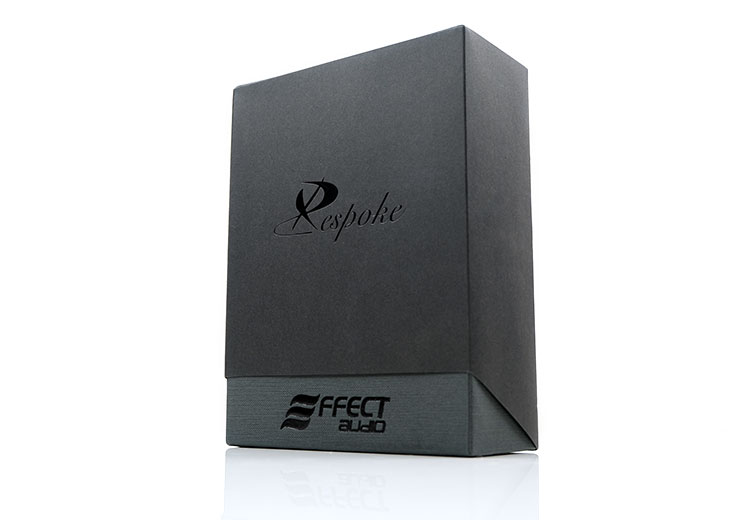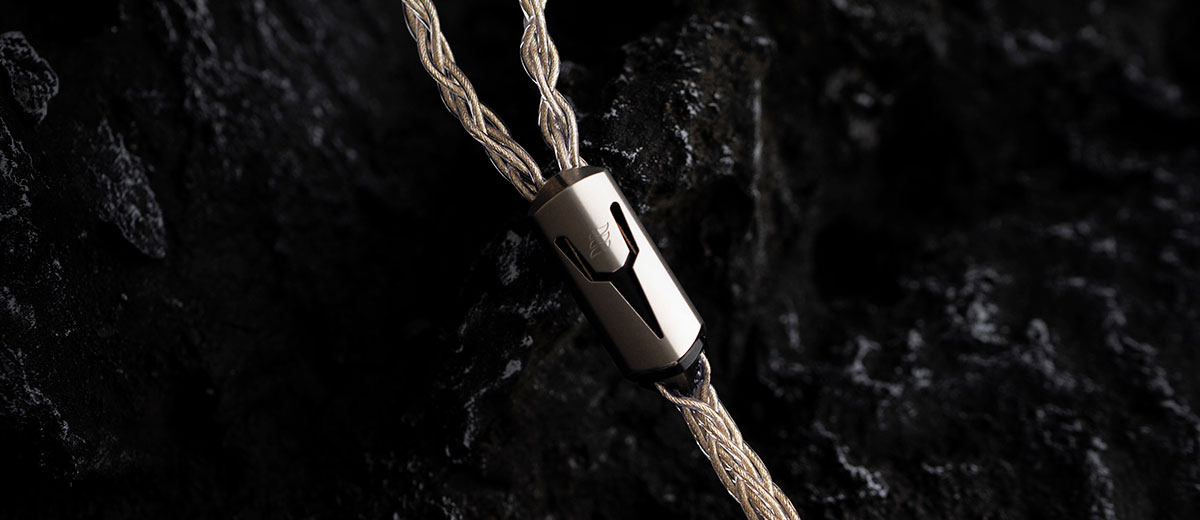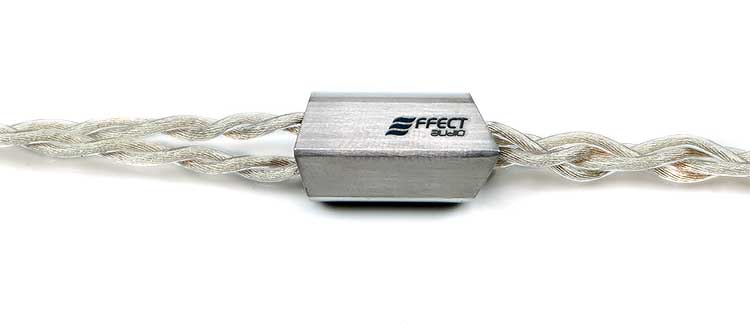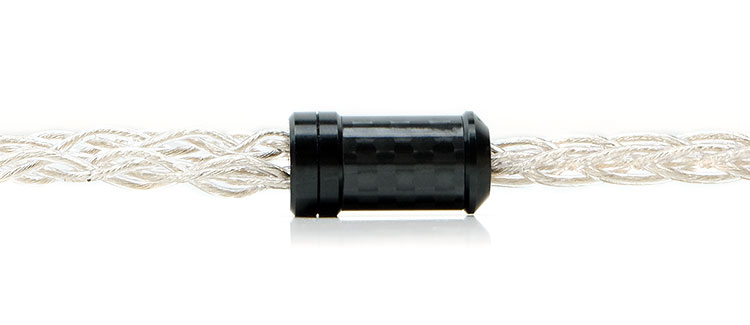Select Comparisons
All comparisons were done with the 64 Audio tia Trio and the Empire Ears Odin monitors using a Lotoo PAW Gold Touch source.
Effect Audio Code 51
$2388
Code 51 was the flagship cable but it is now dethroned by the Centurion in EA’s Hall Of Fame line-up. Code 51 won our award for best cable in our Top Gear of 2020.
Technical
Two distinct philosophies here in terms of geometry and wire mix. The first is the Code 51’s less is more approach with a thicker 24AWG 4-wire as opposed to Centurion’s lighter 26AWG wire but larger 8 wire count. It does make the Centurion the bigger of the two cables physically.
The second is the use of palladium in Code 51 which was a running theme for 2019-2020 and is now absent in the Centurion which veers more to the Horus X mix of silver and gold plating.
Both are still relatively complex wires, however, Code 51 is a hybrid of gold-plated silver, silver-gold alloy, and palladium-plated silver strands whereas the Centurion uses a UP-OCC gold-plated silver-gold alloy in a single strand meaning all wires are the same.
Both cables do use a proprietary 7-core Litz build with multi-sized stranding with Code 51 using the additional Golden Ratio for the layering of the wires as well as individually enameled wires which the Centurion does not have.
Design
The 8-wire Centurion is the bigger and slightly heavier of the two cables despite Code 51 having a wider wire diameter. Code 51 is therefore the lighter of the two both on the ear and in the hand though both have excellent low microphonics performance.
Both cables come packed with transparent EA’s UltraFlexi™ Insulation jacket which allows their composites to shine through. The Code 51 has more of a matte tone to its aura and the Centurion a bit more shimmer to its paler tone. Neither cables have any memory retention issues.
Both cables are finished with titanium splitters with ConX an option on Code 51 whereas with Centurion its is on by default and included in the price. EA has also equipped Code 51 with a chin cinch which the Centurion does not have.
The Centurion goes further than Code 51 in the design stakes with its more elaborate and slightly larger Italo-Corinthian mask aesthetic on the splitter and well as a black guide at its base. It also uses titanium for the connector and jack barrels whereas Code 51 uses the regular EA carbon fiber printed silver plug and smaller connector.
Performance
The Centurion is the more expansive and complex-sounding of the two cables when paired with the Odin and the tia Trio. It makes the Code 51 sounds comparatively center-orientated with its bass response to midrange coming more into focus.
Despite the excellent body on the bass from Code 51, the Centurion actually delivers a better bass dynamic range from the tested monitor drivers. What that means is the body might seem thick on Code 51 but it is not quite as well defined so you might perceive the tia Trio dynamic driver, for example, as dominant but comparatively more one-dimensional.
The Centurion bass, on the other hand, sounds really dynamic, punchier, and articulate. The complex bass layering and space it teases out of the Trio dynamic driver are incredible. Nuanced differences between a faster-paced mid-bass punch and an underlying slower sub-bass rumble and decay are fleshed out better.
The other key difference is the treble presence on the Centurion which I find to be more prominent compared to Code 51’s comparatively smoother approach.
Put it this way, Leonidas II is probably the more laid-back of the three, with Code 51 throwing more treble contrast. However, the Centurion takes it a step further with a beautiful clear treble response that really pushes out and wide on our test monitors.
The Centurion treble presence also gives the entire midrange timbre a bit of a lift creating a sweeter tone to our monitors. Whereas Code 51 is somewhat smoother with perhaps a little less dynamic range on vocals compared to the more vivid performance of the Centurion, particularly with the Odin.
Staging
That is important in the final difference, the staging quality of the Centurion which is where I think people are going to pick up on right away. You are getting a much wider stereo image and an airier staging with both the Odin and the tia Trio.
Code 51 sounds a bit more bass and center focused and you could argue it has more warmth on the very low-end but it does not tease out the same dynamic complexity and space as the Centurion, even on the low-end. Imaging for vocals is also a bit more dynamic and vivid sounding on the Centurion, particularly with the Odin where Code 51 is just a shade less expressive.
Overall, Code 51 has excellent power on the low-end but the Centurion has a dynamic quality as well as a more complex and absorbing soundstage with our paired IEMs.
Effect Audio Horus X
$2499
Technical
The Horus X was the last high-end premium cable release we reviewed from Effect Audio last year and true to form it performed very well indeed. IN many ways the Centurion has been inspired by the Horus X with it also using a 26AWG 8-wire 7-core Litz geometry as well as UP-OCC wiring.
It also pays respect to the Horus concept with its use of gold and silver though this time the mix is a bit different with the Centurion using a gold-plated silver-gold alloy strand as opposed to just gold-plated 5N silver.
Both cables use multi-sized stranding in their wiring but I believe neither of these geometries includes the use of Code 51 and the Octa’s enameled strand finishing. Neither have any golden ration techniques in their geometry.
Design
Both the Horus X and the Centurion are finished with EA’s transparent UltraFlexi™ jacket so you get plenty of that wire shine through for the visuals. The Horus X tone is a little more saturated, a slightly stronger gold with a bit less shimmer than the paler sparkle of the Centurion.
In terms of sizing, both are more or less the same size since they are both 26AWG 8-wire builds, however the looser and softer finish of the Centurion braid does give it a different feel when handling. You might get the odd loop to push back into the Centurion whereas the Horus X is much tighter but harder to the touch and around the ear.
Microphonics on incredibly low with both cables below the splitter and the handling is virtually the same in terms of excellent discipline and no memory retention. However, the memory coating is a bit more discreet on the Horus X which I slightly prefer.
Whilst complementary to both designs, the finishing is a grade up for sure on the Centurion with its titanium barrels and that Italo-Corinthian carved visual on the splitter. The darker and simpler black and carbon alternative on the Horus X is lighter but more symbolic of EA’s traditional options. However, it does match the more saturated tone of the Horus X wiring quite well.
ConX is standard with the Centurion whereas it is a $50 optional extra with the Horus X. You can, however, chose from straight or right-angle jacks for the Horus X whereas the Centurion only comes with a straight, albeit high-end titanium plug barrel.
Performance
The differences between these two are a little more nuanced than the Code 51 comparison. In a way, you could almost label this Code X because it has that Horus X extension but with the power and physicality of the Code 51 thrown into the mix.
First up, the dynamic range, and here the Centurion has a slight edge which you can hear primarily in the snap or impact of most instruments and the perception of the black background around it. Instruments just have a better presence whereas the Horus X seems a little softer and more delicate in its delivery and not quite the same distinct black background.
Both can deliver plenty of headroom but in going back to that physicality of instruments you can still hear the difference with high-pitched percussion resonating on the Centurion that bit more. The Centurion on the Odin delivers a solid note with excellent fundamentals and a nice treble influence on the harmonic balance to give each note plenty of bite.
The Horus X, on the other hand, has a more ethereal quality, more high-fidelity in its delivery with a softer fundamental underpinning Odin’s instrumental notes.
That theme continues on the low-end where the Centurion has the better weight, delivering more power into the midrange instrumental harmonic balance of both the Odin and the tia Trio dynamic drivers.
That is where that perception of the greater physicality in the midrange of each monitor lies with the Centurion pairing compared to the Horus X which sounds a bit more relaxed and slightly softer on the Odin.
Overall, the Horus X articulates extremely well but, of the two, the Centurion delivers the better power, the more physical tone, and a blacker background with our paired monitors.
Effect Audio Leonidas II Octa
$1888
Technical
One of the top-performing cables of 2019 is the 8-wire version of EA’s very popular Heritage Series Leonidas II cable, called the Leonidas II Octa. Internally, both cables have a similar 26AWG 8-wire proprietary 7-core Litz build geometry, and both use UP-OCC grade wiring.
Where they do differ is in their choice of materials with the Octa using a mix of palladium-plated silver and a Litz silver hybrid whereas the Centurion uses a more exotic gold-plated silver-gold alloy in its stranding.
Both use multi-size stranding in their wiring though the Octa also has individually enameled golden ratio stranding much like the Code 51 whereas the Centurion wiring does not use this finishing technique.
Design
Because both have an 8-wire 26AWG build, the girth is fairly similar though I do have to point out the sample we have here for the Centurion has a slightly looser braiding so it looks looser but won’t be as hard to touch as the Octa. Neither have any issues with microphonics and both have zero memory retention issues.
Visually both cables have beautiful designs with the Octa going for a light and organic mix of tan and black Patina style leather as well as a silvery shimmer from the wire under its EA UltraFlexi™ jacket.
The Centurion also uses the same EA UltraFlexi™ jacket but the shimmer from its pale gold-tone is a bit stronger. It also uses more complex and probably more expensive titanium barrels for the eloquently designed splitter, jack, and connectors.
The Octa opts for that Patina leather coated short splitter barrel, the regular smaller chrome and carbon fiber printed connector, and jack barrels. Of the two, the Centurion is just marginally heavier due to the bigger barrels as well as the ConX system which this Octa does not use. You can now order ConX with an Octa which may add a tiny bit more weight.
Performance
The big difference here between these two is what is happening at the extreme ends of the FR with our paired monitors. The Centurion simply delivers more. That means more headroom, more treble presence, more low-end power, and more depth.
The Octa is beautifully holographic in its own right but its treble and bass presence fades a little in comparison. In turn, its midrange timbre is slightly softer, more analog in tone with our paired Odin, and not quite as crisp and precise in notes attacks as the Centurion.
Instrumental notes seem to turn on a dime with the Centurion with a blacker background capitalizing on a very fast transient response from the Odin dual dynamic driver.
The weight in midrange instruments notes is also a bit more satisfying using the Centurion with the tia Trio’s dynamic driver. Again, that comparative low-end fade from the Octa just shaves off a little bit of thrust from the tia Trio’s low-end whereas the Centurion keeps it very tight and dynamic sounding.
Overall, the Octa is a more relaxed and easy listening offering and maybe the more forgiving of the two cables. The Centurion is the more planted, the more dynamic, and consequently the more vivid of the two presentations with our tested monitors.

Our Verdict
The Effect Audio Centurion is a dynamic, expansive, and exquisitely resolving cable pairing with just about every capable monitor I tested. Yes, it does out slam Code 51 and yes, it does widen the imaging field over the Horus X, markedly so.
It is also a beautifully designed cable with an even more intricate titanium finishing and lavish accessories than what was initially seen on Code 51. Would I have liked a tighter braid? Possibly, but that’s just me. Others may welcome the softer feel of the new cable over the older harder finishing.
Who will get this? Good question because it is beyond most budgets but if you already have a Horus X and a Code 51 then you have spent more on them than the Centurion. So, let’s put it this way. The Centurion is for the high roller who wants one cable that works really well with multiple TOTL monitors.
It might be a case of the tail wagging the dog for one monitor only unless you are a King Arthur user but as an end game for several high-end monitors, the Centurion is pretty much all you need.
Effect Audio Centurion Specifications
- 26 AWG 8 Wires
- Gold-Plated Silver-Gold Alloy UP-OCC
- 7 Core-Bundling
- Multi-Sized Stranding
- EA UltraFlexi™ Insulation
- Superior Pentaconn 4.4mm plugs
- Titanium Shelled ConX® Interchangeable Connector








